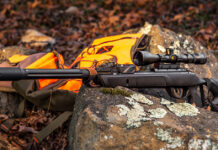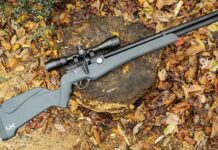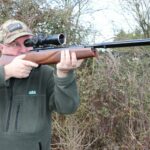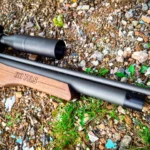Ryan Graves
When it comes to historical duck calls, the Glodo name is recognized as being the “pinnacle” of all calls amongst collectors, especially those that collect vintage calls from Illinois and Tennessee. The Glodo name is also accompanied with much mystery and lore. The first mention of an overall Glodo duck call was in Nash Buckingham’s 1928 article, “The Neglected Duck Call” which read:
“Swamp angels and market hunters of that day, however mothered by apparent necessity, were using handmade calls not much different than today’s models. As in most contrivances, our best calls spring from those most early modes. The most noted of early calls was the Glodo, made, I think, by a Frenchman famed for his prowess with gun and call on a once well-known Southern Illinois marsh. My friend, Guy Ward, of Reelfoot Lake and trap shooting fame, is the proud possessor of an original Glodo. I have heard that as a reed producer and toner, Glodo’s experimental turn for metal manipulation was a little short of marvelous.”

Up until the 1980s, it was thought that Victor Jr. was the only call maker in the Glodo family to make calls. Through the vast and relentless research of Mr. Gerald Droge of Anna, Illinois, it is now known that many Glodo family members made calls.
It all started in 1840 when Victor Glodo Sr. immigrated to the United States from France. Victor Sr. landed in southern Illinois, outside of St. Louis, where he met a local woman, got married and started a family. His first son, Victor Glodo Jr., was born in 1845, and his second son, John Nicholas, was born in 1847. At some point in the late 1850s, Victor Sr. lost his wife. Soon after he packed up the two boys and moved to Degonia Township in Jackson County in southern Illinois. Degonia is located along the Mississippi River bottoms between Chester and Murphysboro, Illinois.

In July 1862, both Victor Sr. and Victor Jr. volunteered for service in the Union Army. Victor Sr. was honorably discharged a few months later after suffering a heat stroke and returned to Degonia. Victor Jr. remained in the service and returned home in 1871. Around the same time, Victor Sr. remarried, and his third son, Albert Henry Glodo was born. At this time they were all living down the road in Fountain Bluff where the Big Lake Marsh was located that was earlier mentioned in Nash Buckingham’s article. During this time, they were hunting ducks for the market and when they started to make duck calls.
It can be rather difficult trying to figure out which members of the Glodo family made individual calls that are attributed to them but a trained eye can say that a duck call was more than likely made by one of the family members.

It is not known for certain that Victor Sr. made calls but early records show that he worked as a carpenter and a blacksmith so one could infer that he probably did. It is known though that all three of Victor Sr.’s boys made calls. The calls made by Victor had rounded shoulders, a bulbous stopper, and had a copper reed. Victor made both smooth barrel and checkered calls. His calls were very well made considering that he made them all by hand using homemade carving tools.
The calls made by John Nicholas mostly had flat tops, copper reeds, and a checkering pattern much different than that of his brother Victor. It was stated in an early article of Forest and Stream that John Nicholas was selling calls for as much as $10 in the early 1890s. The calls thought to be made by Albert Henry were similar in design to that of John Nicholas’ but were a bit smaller in stature and the checkering pattern was a little more refined.

In 1888, the Big Lake Marsh where the family market hunted was drained. The once waterfowl rich area would now be farmed for row crops. To continue hunting for the market, Victor Jr. packed up and headed to Reelfoot Lake in northwest Tennessee, and John Nicholas headed for the Big Lake area of northeast Arkansas, near Blytheville, only later to return home.
During this timeframe, John Nicholas’ oldest son, William Albert, started to make duck calls as well as Albert Henry’s two boys, Joseph E. and Walter Albert. The calls thought to be made by William Albert are similar to the calls his dad made but are much more crude. Calls that are attributed to Walter Albert are shorter in stature and have raised panels. Some of his calls have some checkering on them and others do not. Calls attributed to Joseph E. are well made but rather plain in design. The family sold their calls at a general store in Raddle for $1 or $2 apiece. The last of the Glodo family known to have made calls was William Albert’s son, Arzia Emerson, who was born in 1902. Arzia carved things such as ducks, geese, and snakes into his calls.

Although Victor Jr. made duck calls while living in Illinois, it was at Reelfoot Lake where his legend and legacy became larger than life. It is known that Glodo lived in a tent camp on Starve Island where he market hunted and fished commercially. He seemed to have made quite an impression on the locals with his knowledge of the area, hunting ability, and for the duck calls that he was making. He was the person that introduced duck calls to the Reelfoot area, so it didn’t take long before the locals began to hound him for calls. The calls that Victor made while in Tennessee are a much more refined version of what he made while living in Illinois but the calls that he made in his later years of life show that his woodworking skills were diminishing. Around 1900, Victor moved off of Starve Island to an area now known as “Glodo Hollow” on the old Lake Road in Samburg. This is where he died in 1910.

His call making left a legacy in the Reelfoot area and set the standard for many area call makers after he passed. The two most noted call makers that used his design were Sundown Cochran and Tom Turpin. In a 1931 Field and Stream article, Turpin wrote:
“After getting the opinion of many of the most expert duck callers in the country, I decided that the best model is the call produced by Glodo, an old-timer of the jack-knife-school of artists, who made his calls at Reelfoot Lake some twenty years ago. Glodo’s model is on the same principle as the Beckhart and Faifer, both of which are good calls and should satisfy any hunter. I prefer the Glodo for certain features; I think the groove is better shaped, the general proportions better and the reed is wider and shorter”

Consider yourself lucky if you have a Glodo family made duck call in your collection as they are very rare and valuable. You can see early examples of Glodo family calls from my collection that are on display at the Ducks Unlimited Heritage Center in Memphis at Bass Pro Shops Pyramid until September 2022. I can be reached at rkegraves@gmail.com and @rkegraves on Instagram.











































![Air gun 101: The differences between .177 & .22 – Which jobs they do best ? [Infographic]](https://airgunmaniac.com/wp-content/uploads/2024/11/1773-150x150.jpeg)